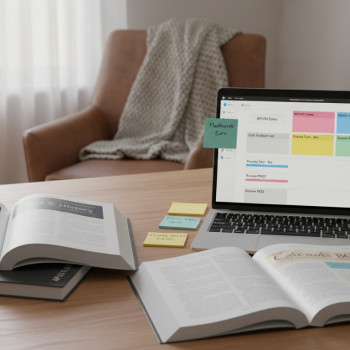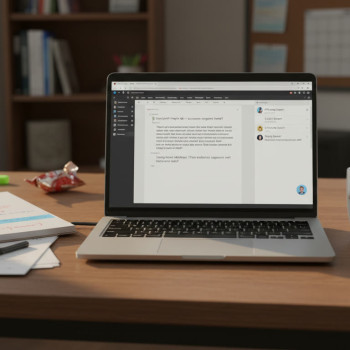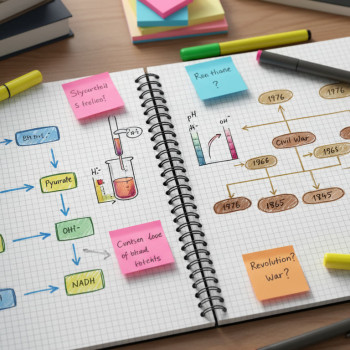Why a 2-Year AP Plan Matters (G10–G11)
Imagine walking into your senior year with confidence — not scrambling to pick last-minute courses or stress about unpredictable workloads. A thoughtful 2-year AP plan across Grade 10 and Grade 11 gives you that calm. It spreads academic rigor so you can build deep knowledge, develop exam skills, and keep space for extracurriculars, leadership, and sleep. This guide walks you through a step-by-step approach to design a plan that’s ambitious yet realistic, evidence-friendly, and tailor-made for your strengths.

Step 1 — Start With Goals, Not Courses
Before you list AP classes, ask three simple questions:
- What do I want my transcript to say? (Depth in a subject, breadth across disciplines, or both?)
- What are my college or career interests now, and how likely are they to change?
- How do I perform under academic pressure, and what are my non-academic priorities?
Your answers shape the plan. For example, an aspiring engineer might prioritize AP Calculus and AP Physics across G10–G11, while a prospective humanities major could focus on AP English Language, AP US History, and AP Research/English Literature by G11.
Real-World Example
Sam wants computer science; they choose:
- G10 — AP Computer Science Principles (if available) and honors math
- G11 — AP Calculus AB and AP Physics 1 (or AP Computer Science A in place of Physics)
This sequence builds programming and quantitative foundations while leaving senior year flexible.
Step 2 — Audit Your Current Academic Status
Take an honest inventory of your strengths, weaknesses, and schedule:
- Grades and teacher feedback: Which subjects do you excel in? Which need improvement?
- Course prerequisites: Some APs require or recommend prior classes (Algebra II before Calculus, for example).
- Time budget: How many AP-level courses can you handle without burning out? Two is a comfortable number for many students; three is doable if you have strong habits and support.
Practical Audit Template
| Category | Details |
|---|---|
| Core Strengths | Subjects with A/B grades and positive teacher remarks |
| Growth Areas | Subjects with C or lower, or inconsistent performance |
| Time Commitments | Hours/week for extracurriculars, part-time job, family duties |
| Support Needed | Tutoring, peer study groups, or time-management coaching |
Step 3 — Map AP Choices Over Two Years
Balance is the north star here. Ideally, stagger the most challenging APs so you’re not taking multiple high-workload classes the same semester.
Common Two-Year Patterns
- Depth-Focused (STEM): G10 — AP Physics 1, AP Computer Science Principles; G11 — AP Calculus AB, AP Physics C or AP Computer Science A.
- Breadth-Focused (Humanities): G10 — AP World History, AP Language; G11 — AP US History, AP Literature.
- Balanced Mix: G10 — AP Biology, AP English Language; G11 — AP Chemistry or AP Statistics, AP US History.
Use the audit to refine these patterns. If you struggle in math, delay AP Calculus to G11 only if G10 includes a supportive honors math track.
Step 4 — Create a Semester-by-Semester Timeline
A two-year plan becomes actionable only when you translate it into semesters and concrete milestones. Here’s what to include:
- Course List per semester (AP and supporting classes).
- Key academic milestones: major projects, labs, and mock exams.
- Practice-exam cadence: when to take practice Sectionals, full-length exams, and scoring sessions.
- Extracurricular checkpoints: leadership commitments, competitions, or portfolio items.
Sample G10–G11 Semester Timeline
| Semester | Core APs / Focus | Milestones |
|---|---|---|
| G10 Fall | AP World History, Intro Honors Math | Diagnostic exams, begin weekly review habit |
| G10 Spring | AP Biology (if available), Continue World History | First full-length practice AP in April |
| G11 Fall | AP Calculus AB, AP Physics 1 or AP English Language | Monthly timed sections, start college-level reading habits |
| G11 Spring | AP Calculus AB (continued), AP US History or AP Chemistry | Official practice exam in March, review sprint in April |
Step 5 — Build Study Routines That Stick
AP skills are cumulative: vocabulary, problem-solving patterns, and evidence-writing get better with consistent practice. Schedule short, focused sessions rather than occasional marathon cramming.
- Daily 25–45 minute focused blocks per AP subject (Pomodoro-style).
- Weekly review for each subject: revisit notes, rework past problems, and refine outlines for essays.
- Monthly full timed practice for at least one subject to build stamina and pacing.
Active Study Techniques That Work
- Write quick outlines for free-response questions before checking model answers.
- Create one-page concept maps for every unit you study.
- Use spaced repetition (flashcards) for vocabulary, formulas, and key dates.
Step 6 — Practice Smart With Exams and Feedback Loops
Take practice AP exams under realistic conditions and then treat the scoring as a diagnostic, not a verdict. Build a feedback loop:
- Identify the top three recurring errors (content gap, pacing, or misunderstanding of question types).
- Create targeted mini-lessons (30–60 minutes) to address each error weekly.
- Track progress in a simple spreadsheet so small gains are visible.
Example Feedback Loop
If your AP Chemistry practice shows weak free response performance: first isolate whether the issue is calculation mistakes, conceptual gaps, or poor structure. Then do a two-week micro-plan: focused concept review days, a calculation practice set, and one timed FRQ every weekend with peer or tutor review.
Step 7 — Use Support Strategically (Tutors, Teachers, and Tools)
Getting help is efficient — not a sign of weakness. Use support to accelerate learning, fix stubborn gaps, and refine exam technique.
- Teacher Office Hours: best for course-specific clarifications and standards-based feedback.
- Peer Study Groups: great for accountability and different perspectives.
- 1-on-1 Tutoring: ideal for personalized pacing and targeted remediation — for many students, short bursts of expert help before a big exam produce outsized benefits.
Programs like Sparkl’s personalized tutoring can fit naturally into this plan because they offer one-on-one guidance, tailored study plans, expert tutors, and AI-driven insights to identify weak spots quickly and help you act on them — particularly useful in G11 when stakes are higher.
Step 8 — Balance Workload and Wellbeing
AP success isn’t only about time spent; it’s about sustainable energy. Prioritize sleep, nutrition, and unplugging rituals so cognitive performance stays high.
- Protect 7–9 hours of sleep nightly when possible — memory consolidation happens during sleep.
- Schedule at least one weekly activity that’s purely relaxing (friend time, sport, or creative hobby).
- Use a planner to visually balance heavy and light academic weeks; shift focus when a major deadline looms.
When to Say No
If an additional AP would push you into chronic late nights or you’d have to drop a meaningful extracurricular, it’s better to aim for depth than overload. Colleges prefer sustained commitment and excellence in a few areas over shallow breadth.
Step 9 — Senior-Year Flexibility: Why G10–G11 Planning Helps
With a smart two-year AP plan, senior year becomes a time to:
- Take an AP you weren’t ready for earlier, or
- Retake an AP exam (if you want to improve your score), or
- Focus on capstone projects, college essays, or internships.
That flexibility is one of the biggest hidden benefits of planning early — it turns the final high school year into a strategic advantage, not a race to check boxes.
Step 10 — Example 2-Year Plans (Specific Templates)
Below are three practical templates you can adapt. Each assumes school offers the listed APs and that students have the prerequisites or honors tracks needed.
Template A — STEM-Intensive
- G10: AP Computer Science Principles, Honors Algebra II; build programming projects.
- G11: AP Calculus AB, AP Physics 1 (or AP Computer Science A), practice full-length math/physics sections monthly.
Template B — Humanities-Focused
- G10: AP World History, AP English Language (if offered), start timed essay habits.
- G11: AP US History, AP Literature, prioritize primary-source analysis and thesis-driven essays.
Template C — Balanced
- G10: AP Biology, AP World History.
- G11: AP Chemistry or AP Statistics, AP English Language, rotate focused review weeks for each subject.
Step 11 — Track Progress With a Simple Dashboard
Create a one-page dashboard (digital or paper) that you update weekly. Key fields:
- Target AP Exams and planned year (G11 spring is typical).
- Weekly hours spent per AP subject.
- Last practice score and trend over time.
- Top three action items this week (e.g., rewrite FRQ #2, finish unit review).
Table: Example Dashboard Snapshot
| AP Subject | Planned Exam Date | Last Practice Score | Weekly Study Hours | Top Action |
|---|---|---|---|---|
| AP Calculus AB | May, G11 Spring | 72% | 6 | Timed past exam sections |
| AP English Language | May, G11 Spring | 68% | 4 | Write 2 timed essays |
| AP Biology | May, G11 Spring | 80% | 3 | Review lab report structure |
Step 12 — Common Pitfalls and How to Avoid Them
- Taking on too many APs at once: stagger difficult subjects and lean on support for peak months.
- Neglecting exam skills: content knowledge is necessary but not sufficient — practice pacing and question interpretation.
- Ignoring teacher feedback: teachers often know the rubrics and common errors; use their insights.
- Waiting until senior year: that reduces options and increases stress; start planning now in G10.
How to Use Tutoring Wisely in Your 2-Year Plan
Not all tutoring is the same. The highest ROI comes from:
- Short, focused sessions on weak topics rather than weekly broad reviews on everything.
- Working with tutors who know AP rubrics and scoring patterns.
- Using data-driven insights to prioritize study (e.g., targeted practice where you miss most points).
Sparkl’s personalized tutoring model fits these needs: one-on-one guidance, tailored study plans, and tech that highlights learning gaps so your sessions are efficient and goal-oriented. Consider tutoring sprints before major mock exams or during the final review sprint in April of G11 spring.
Final Checklist: Ready to Launch Your 2-Year AP Plan
- Goal clarity: transcript narrative and likely college/career interests set.
- Course audit completed: prerequisites and teacher recommendations checked.
- Semester timeline created with milestones, practice exams, and review windows.
- Routine and dashboard set up for weekly tracking.
- Support plan: teacher, peer, and tutoring touchpoints scheduled.
- Wellbeing commitments: sleep, breaks, and time for meaningful activities protected.
Parting Encouragement
Building a high-performing AP roadmap is a marathon built from smart sprints. Start small, iterate every month, and give yourself permission to adjust — the plan isn’t a contract; it’s a tool to help you learn better and feel more in control. When you act early (in G10) and refine through G11, you’ll enter senior year with options: a chance to shine on AP exams, pursue depth projects, or present a focused, purposeful transcript to colleges.
If you’d like a personalized review of your planned courses, a practice-exam strategy, or targeted tutoring bursts, consider pairing your plan with one-on-one support. Services like Sparkl can provide tailored study plans, expert tutors, and AI-driven insights to help you turn effort into higher scores — and more importantly, clearer understanding.
Ready to Start?
Open your calendar, draft the first semester, and set a 30-minute planning session this week. That small act—mapping one semester thoughtfully—will put you miles ahead of last-minute planners. Good luck; you’ve got this.
























No Comments
Leave a comment Cancel